|
Having trouble reading this email?
View it on your browser or download the PDF.

IN THIS ISSUE
 |
Food Security in the Horn of Africa: The Implications of a Drier, Hotter and More Crowded Future
Nearly 44 per cent of the population in the Horn of Africa is already subject to extreme food shortages. What will happen if the population continues to grow and climate change exacerbates the harsh conditions?
|
Thematic Focus: Ecosystem Management, Climate Change
Food Security in the Horn of Africa: The Implications of a Drier, Hotter and More Crowded Future
Why is this issue important?
The Horn of Africa is one of the world's most food-insecure regions. The eight countries – Djibouti, Ethiopia, Eritrea, Kenya, Somalia, Sudan,
South Sudan and Uganda – have a combined population of 160 million people, 70 million of whom (or nearly 44 per cent) live in areas prone to
extreme food shortages (1). Between 1970 and 2000, these countries were threatened by famine at least once each decade (1). In the future, the
impacts of climate change, as well as growing populations and declining per capita agricultural capacity, are expected to further threaten
food security¹. As one of the least developed areas in Africa, there is limited capacity to respond to drought or food crises. To prevent
humanitarian emergencies, the Horn of Africa needs to strengthen its ability to build long-term resilience and tackle the root causes of
the region's vulnerability.
¹ Food security has a variety of definitions. Common to these are issues of food availability, access and use (35).
The World Food Summit adopted the following definition, "Food security, at the individual, household, national, regional and global levels [is achieved]
when all people, at all times, have physical and economic access to sufficient, safe and nutritious food to meet their dietary needs and food preferences
for an active and healthy life" (36). According to the Food and Agriculture Organization, food insecurity exists when people do not have adequate physical,
social or economic access to food as defined above (36).
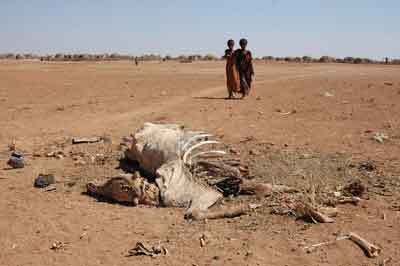
Full Size Image
Figure 1: Cattle losses and forced cattle sales at low prices for lack of feed and water have been reported across the pastoral areas in the Horn of Africa. Photo: Andrew Havens / Flickr
The Horn of Africa is currently facing a humanitarian crisis. Nearly 13 million people were in need of assistance in September 2011 (2, 3). Not since the 1984/85 famines in
Ethiopia and Sudan, during which over 1 million people died, has there been such a widespread food emergency (4). In Somalia alone, 4 million people were suffering from acute
food crisis or outright famine in September 2011 (5). If the response is inadequate by October, 750,000 people risk dying in the following four months (5). Tens of thousands
of people have already died, half of whom are children. In Ethiopia, 4.5 million people have required emergency humanitarian assistance due to poor rains and extremely high
food prices (6). In Kenya, 3.75 million people are considered food insecure. Although the onset of rains in October is expected to bring some relief, pastoral
conditions continue to deteriorate and underlying causes of food insecurity remain (7).
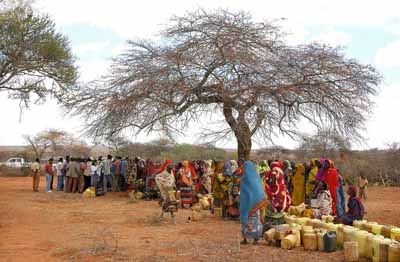
Full Size Image
Figure 2: Women queue for water near Moyale in the Oromiya region, just east of the Ethiopian Highlands. This area is one of the worst affected by the 2011 drought. Photo: Andrew Havens / Flickr
A variety of factors contribute to food insecurity in the Horn of Africa, including drought, environmental degradation, poverty, conflict, population growth,
land fragmentation and stagnating agricultural development (1, 8, 9, 10, 11). Food supplies in large parts of the developing world are locally derived and much of the
agriculture is rain-fed (9, 10). As a result, rainfall and temperature changes directly influence food supply. Water shortages and heat stress limit crop growth and
development, reducing yield (12). Since the mid-1980s, rainfall during the main growing season has declined by 15 per cent across eastern and southern Africa (10). Over
the same period, per-capita cropped area declined by 33 per cent while the population of eastern and southern Africa doubled (Figure 3) (10). While droughts are naturally occurring
phenomena in the Horn of Africa, changes such as population growth as well as environmental degradation, land fragmentation and conflict, have increased vulnerability and
decreased the adaptive capacity of communities. Rainfall declines and erratic weather may thus tip households over the edge into livelihood crises (1, 11).
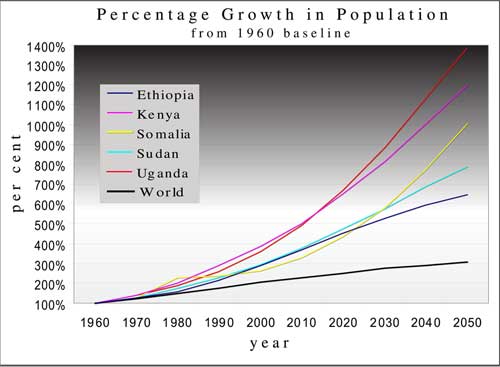
Full Size Image
Figure 3: Since 1960 population growth across the horn of Africa has dramatically outpaced global population growth.
Uganda's population is projected to grow to 14 times its 1960 population by 2050. Data: UN Population Division 2011
Case Study: Sudan and South Sudan
According to a Famine Early Warning Network (FEWS NET) climate analysis, Darfur in western Sudan and much of South Sudan have experienced a 10-20 per cent decrease in long-rains
since the mid-1970s (18). The long-rain season, the period during which relatively heavy and steady rains are common, typically occurs in Darfur and South Sudan from June through
September. Long-rains are crucial to the region's main harvest. Since the 1960s, however, drought has become more frequent and more widespread during these months (19, 20).
Between the 1960s and late 2011 the area receiving adequate rainfall (500 mm) to support agro-pastoralist livelihoods had been reduced by 18 per cent due to the reduced rainfall
trend (Figures 4 and 8) (18). In these semi-arid and dry subhumid zones, rain-fed agriculture is already tenuous due to the seasonality of rainfall, intermittent dry spells and
frequent drought years (21). In addition to the 30-year trend of declining precipitation, there is evidence that variability in amount and timing of rainfall from year to year is
increasing, which would further compound food insecurity in the region (20, 22, 23).
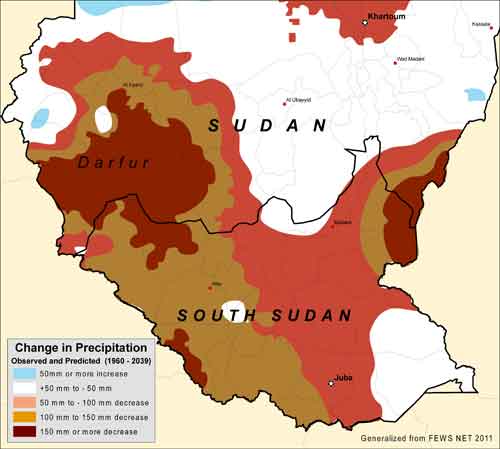
Full Size Image
Figure 4: Combining observed reductions in rainfall since 1960 with predicted reductions between 2010 and 2039, some areas of South Sudan and a large portion
of Darfur in Sudan would see reductions of over 150 mm in June – September rainfall. Most of this change (63 per cent) already occurred between 1960 and 2009.
An accompanying trend of higher temperatures (18, 20) (Figure 5) – estimated to be equivalent to an additional 10 to 20 per cent reduction in rainfall in its impact on
crops (18) – has exacerbated the reduced and increasingly variable rainfall. Air temperatures in the area have increased by over 1.0° C since the 1970s (18). As with
rainfall, there is evidence that average annual temperatures have become more variable as well (20).
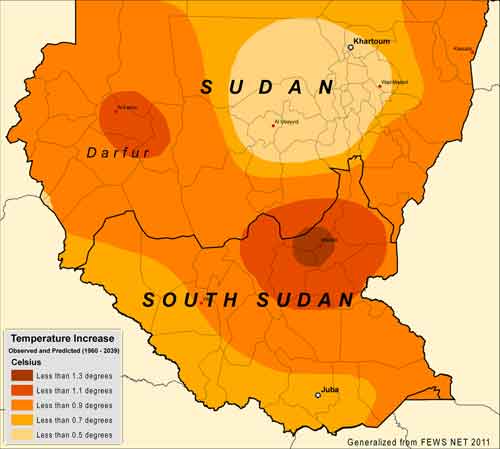
Full Size Image
Figure 5: Adding temperature increases already observed in Sudan and South Sudan with predicted increases through 2039, most of the
area shown above will experience an increase of between 0.5° C and 1.3° C from 1960 to 2039.
During roughly the same time that these trends in temperature and rainfall have made rain-fed agriculture less secure, the combined population of Darfur and South
Sudan has roughly tripled (24, 25). Since 1960, the population of the area that is now South Sudan has grown from around 2.5 million to over 7.5 million and
Darfur's population has grown from around 1.5 million in 1960 to an estimated 6.7 million by 2010 (24, 25). Population in the two areas is expected to grow by an
additional 1.4 million people by 2015 (24). The vast majority of people in these areas rely on some type of agro-pastoralism (26).
Sudan is not alone
The downward trend in long-rains extends to other countries across the Horn of Africa and is particularly strong to the east of the
Ethiopian Highlands and in Central Kenya (15). FEWS NET released a report for Kenya in August 2010, based on similar methodologies and
data sets. The authors used historical data from 70 rainfall stations and 17 air temperature stations to interpolate the long-rains
precipitation and temperature trends for all of Kenya from 1960 to 2009 (27) (Figures 6 and 7). In Kenya, long-rains traditionally occur
between March and June. The authors report that Kenya has experienced the same trend of decreasing rainfall and rising temperatures as Sudan.
In Central Kenya, one of the countries key agricultural regions, the area receiving adequate rainfall to support reliable rain-fed agriculture has
declined by roughly 45 per cent since the mid 1970s (27) (Figure 7).
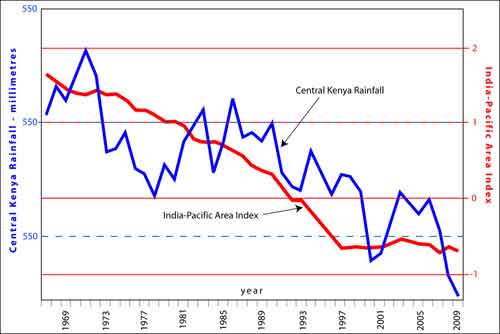
Full Size Image
Figure 6: The trend in rainfall for Kenya since the 1960s tracks the trend in the Indian-Pacific Area circulation index–a measure of temperature and precipitation over the Indian and western Pacific Ocean.
A FEWS NET report published in 2005 concluded that south-western Ethiopia has also seen a long-term post-1960s downward trend in rainfall (19).
More recent, yet to be published, analysis based on 110 years of observation from 215 rainfall gauges indicates that, since the mid-1970s, rains
may have declined by 15-20 per cent in some areas of Ethiopia (28). The spatial pattern of decline appears to coincide with heavily populated areas
of southern and south-eastern Ethiopia, and may have adversely affected crop yields and pasture conditions. Substantial warming across the entire
country may have also occurred, exacerbating the dryness (28).
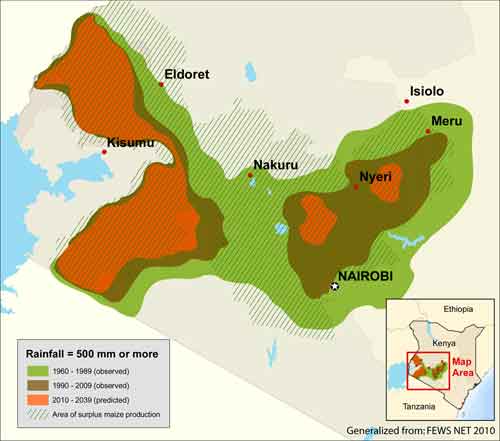
Full Size Image
Figure 7: The area of west-central Kenya receiving 500 mm of rain or more has shrunk since 1960 and is likely to keep shrinking over the next 30 years.
Another FEWS NET preliminary analysis of data from Uganda appears to show that seasonal rains have decreased over the past 25 years there as well.
Between 2000 and 2009, the average March-to-June and June-to-September rainfall in maize growing regions was about 8 per cent lower than the 1920-1969
mean (29). Such rainfall declines may threaten food production in the west and northwest. Observed warming of more than 1.0° C may have also affected
crops and pastures, with adverse impacts on coffee production in the south (29). The final FEWS NET reports on Ethiopia and Uganda are expected to be published soon.
What will the future bring?
There is widespread consensus that climate change will further worsen food security in Africa (13). However, questions remain over the precise
impact on rainfall and temperature trends. The Intergovernmental Panel on Climate Change's (IPCC) 2007 assessment reports that 18 out of 21 models
predict increased rainfall in East Africa, extending into the Horn of Africa (14). Actual rainfall records since the 1970s, however, indicate
precipitation has declined, and a recent study predicts continued declines in the future (4, 10). The IPCC has acknowledged its models have
difficulty representing regional processes affecting rainfall (27).
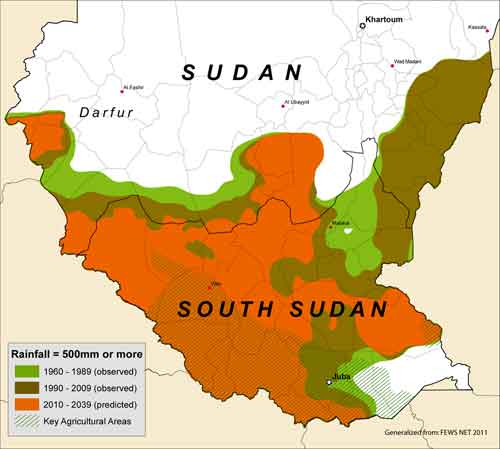
Full Size Image
Figure 8: Five-hundred millimeters of rain is a rough "rule-of-thumb" measure of agricultural viability. The area of South Sudan and Sudan currently meeting this threshold is expected to shrink by 30 per cent between 1960 and 2039.
While long-term precipitation predictions are uncertain, research by A. Williams and others (15, 17) has indentified a relationship
between declining March-to-June precipitation in the Horn of Africa and a trend in rising sea-surface temperatures (SSTs) in the south-central
Indian Ocean and western Pacific Ocean between 1960 and 2009 (Figure 6). This heat causes enhanced convection over the tropical Indian Ocean.
They believe it is driving a pattern of descending dry air over eastern Africa, which has been suppressing convection over East Africa since
1980 and decreasing precipitation during the March-to-June rains. The authors assert that the rising Indian Ocean sea surface temperatures have
been convincingly linked to anthropogenic greenhouse gas and aerosol emissions and the consequent climate forcing (15, 16, 17 27). Thus, they
suggest, continued increases in greenhouse gas concentrations in the atmosphere will likely continue to warm the south-central Indian Ocean,
perpetuating the drying trend across East Africa (15, 17).
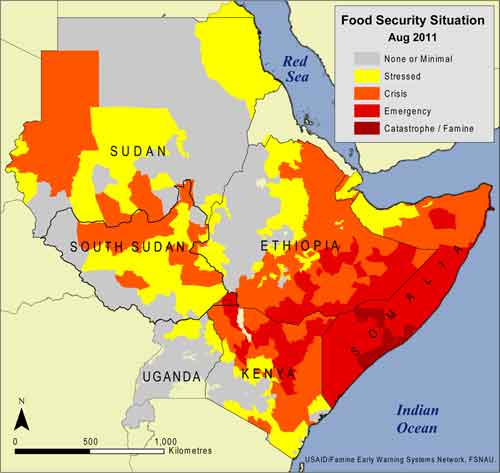
Full Size Image
Figure 9: The Famine Early Warning System classified much of the Horn of Africa as being at some level of food insecurity, from "stressed" to "famine".
The FEWS NET climate analyses for Kenya, Sudan and South Sudan and the soon to be released analyses for Ethiopia and Uganda use rigorous
analysis of station data to establish a drying and warming trend over much of the Horn of Africa since the 1960s, which they describe
as a clear departure from the long term climatic norm (18). They predict a continuation or intensification of below normal rainfall based
on the relationship established between Indian Ocean SSTs and East African climate patterns (15). They conclude that the apparent link
between Indian Ocean warming and observed drying in Kenya (Figures 6 and 7) "may indicate that continued [precipitation] declines are
likely over at least the next several decades" (27). Long-rains have declined more than 100 mm already in parts of west-central Kenya.
Projections for the next 15 years indicate that additional areas of Kenya would see a drop in precipitation during the long-rain season
in excess of 100 mm by 2025. Likewise, FEWS NET analysis predicts that the area of South Sudan and Darfur receiving adequate precipitation
for rain-fed agriculture (500 mm or more) will decrease by 30 per cent (18). These areas are home to around 16 per cent of Sudan and South
Sudan's combined population, or around 6.5 million people (24). The yet to be published reports for Ethiopia and Uganda have similar findings (28, 29).
What are the implications?
The current vulnerability of the region to climate-related food insecurity was brought into the international spotlight as drought intensified
through the 2011 long-rains season. Food shortages accumulating from consecutive years of drought created food emergencies along a broad swath of
the drought-affected area from Darfur in Sudan, eastwards to southern Somalia where a famine was declared in early August (Figure 9).
In addition to crop failures, the droughts have diminished grazing lands, upon which pastoralists rely for food security. Pastoralism is an effective
productive system in arid and semi-arid ecosystems. It provides insurance to people living in areas of uncertain rainfall across much of the Horn of
Africa, providing a back-up source of food and income (Figure 10). The severity and persistence of droughts over several seasons have left pastoralists
with limited grass and water for their herds; a problem further exacerbated by fragmentation of rangeland and restricted access to key resources. Many
cattle have died for lack of water or food, and in desperation, many herders have been forced to sell cattle at very low prices (30). Poor
livestock-to-cereal terms of trade and high food prices have seriously reduced herders' ability to access food (31). Drought has been particularly devastating
in pastoralist and agro-pastoralist areas of southeastern Ethiopia and northern Kenya (32) (Figure 10). In most of this area, the period between June 2010
and June 2011 was the driest or second-driest in 60 years (32). In some parts of Kenya, 2011 is the third consecutive year of drought (32).
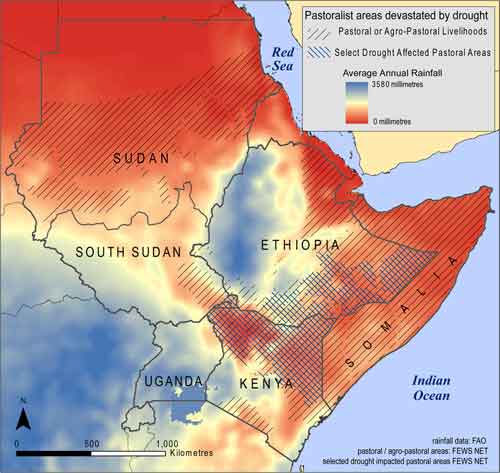
Full Size Image
Figure 10: Pastoral livelihoods offer a form of diversification, which can protect against moderate dry periods. The map shows how
areas of marginal rainfall (yellow-to-orange areas) are where pastoralist and agro-pastoralist livelihoods are practiced (right leaning hatch marks).
FEWS NET identified some areas in Ethiopia and Kenya where pastoralists were seeing record droughts (left leaning hatch marks) – in some cases, the
worst in 60 years. The analysis did not asses conditions in Somalia but pastoralists along the borders with Ethiopia and Kenya are almost certainly
equally affected.
Critical food growing areas in Sudan, South Sudan and west-central Kenya would be seriously affected if predictions about the drying trend in
East Africa are realized. In both Ethiopia and Uganda, rapid population growth and the expansion of farming and pastoralism under a drier
and warmer climate regime could dramatically increase the number of at-risk people over the next 20 years (28, 29). At the same time, however,
the spatially explicit projections outlined above may provide a tool for climate change adaptation by giving an indication of both the scale
and location of possible future food insecurity.
While declines in food production and market failures contribute to household vulnerability, failures of response can lead to famine (11).
Fortunately, positive action has been taken to address the current crisis in the Horn of Africa. For example, the number of beneficiaries of
food aid in Somalia increased in August and September (33). Nearly 75 percent of the 2.4 billion US dollars requested for the Horn of
Africa Drought Appeal has been raised (34). However, with disease outbreaks reported across the region and refugee flows continuing (34),
further massive, multi-sectoral response is critical to prevent additional deaths.
To reduce vulnerability and promote adaptation, a suite of strategies is needed to address the multiple stressors that interact with climate change.
In the short-term, interventions to improve food access are critical. In the medium-term, interventions to support and rebuild livelihoods are
necessary (35). Long-term solutions must include investment in agricultural development and livelihood diversification (9, 10, 11). Modest increases in
per-capita agricultural productivity may offset the agricultural impact of observed precipitation declines (10). Several areas of Ethiopia may maintain
moist climate conditions, and agricultural development could help offset the impacts of declining rainfall (28). Encouragingly, Kenya has seen
increased yields in maize but has more room for improvement since it has not yet reached yields achieved in southern Africa (27). More effective
storage and improved market and transport infrastructure might also improve food security. Additionally, future investment in integrated land
management and ecosystem restoration and protection is invaluable. Healthy ecosystems are critical to reducing vulnerabilities and risk, and
contribute to livelihood resilience.
If action is not taken, massive increases in food-aid expenditures will be required to deal with food insecurity and undernourishment.
Two hundred million sub-Saharan Africans were undernourished in 2002, and if trends continue, this total may increase to almost 600
million people by 2030 (9). The current interaction between vulnerable communities, climate change, ecosystem degradation, population growth,
land fragmentation and limited investment in agriculture is potentially explosive, costly and deadly.
References
1. FAO (2000) The Elimination of Food Insecurity in the Horn of Africa – Summary Report. Rome: Food and Agriculture Organization.
Accessed on October 11, 2011 at: http://www.fao.org/docrep/003/x8530e/x8530e00.htm
2. FEWS NET (2011) East Africa Food Security Update, August 7, 2011. Accessed September 22, 2011 at: http://www.fews.net/docs/Publications/East_Regional_FSOU_2011_08_07_final.pdf
3. Ban Ki- Moon (2011). Remarks at Mini-Summit on Horn of Africa, September 24, 2011. Accessed October 11, 2011 at: http://www.un.org/apps/news/infocus/sgspeeches/print_full.asp?statID=1327
4. Funk, C. (2011) We thought trouble was coming. Nature, 476: 7. Accessed October 11, 2011 at: http://www.nature.com/news/2011/110803/full/476007a.html
5. FEWS NET (2011). SOMALIA Dekadal Food Security and Nutrition Monitoring, September 13, 2011. Accessed October 11, 2011 at: http://www.fews.net/Pages/default.aspx
6. FEWS NET (2011) Ethiopia Food Security Outlook Update, August 25, 2011. Available at: http://www.fews.net/docs/Publications/Ethiopia_Dekadal_08_20_final_ext.pdf
7. FEWS NET (2011). KENYA Food Security Alert, September 19, 2011. Accessed October 11, 2011 at: http://www.fews.net/Pages/default.aspx
8. Atieno Oluoko-Odingo, A. (2011). Vulnerability and Adaptation to Food Insecurity and Poverty in Kenya. Annals of the Association of American Geographers, 101 (1): 1-20.
9. Funk CC, Brown ME (2009) Declining global per capita agricultural production and warming oceans threaten food security. Food Security, 1:271–289
10. Funk CC, Dettinger MD, Michaelsen JC, Verdin JP, Brown ME, Barlow M, Hoell A (2008) Warming of the Indian Ocean threatens eastern and southern African food security but
could be mitigated by agricultural development. Proc Nat Acad Sci USA, 105:11081–11086
11. Devereux, S. (2009). Why does famine persist in Africa? Food Security, 1:25 – 35.
12. Prasad PVV, Staggenborg SA (2008) Impacts of drought and/or heat stress on physiological, developmental, growth, and yield
processes of crop plants. In: Ajuha LR, Reddy VR, Saseendran SA, Yu Q (eds) Response of crops to limited water: understanding and modeling water stress
effects on plant growth processes. American Society of Agronomy/ Crop Science Society of America / Soil Science Society of America, Madison, WI, p 301–356
13. Desanker, P. et al. (2001). Africa, Chap 10. In: McCarthy, J., Canziani, O., Lary, N., Dokken, D., White, K. (eds). IPCC Third Assessment Report,
Working Group II: Impacts, Adaptation and Vulnerability. Accessed Oct 11, 2011 at: http://www.grida.no/publications/other/ipcc_tar/
14. IPCC. (2007). Regional climate projections, Chap. 11 . In: Climate Change 2007 - The Physical Science Basis: Contribution of Working Group I to
the Fourth Assessment Report of the Intergovernmental Panel on Climate Change. Accessed online on January 5, 2011 at http://www.ipcc.ch/ipccreports/ar4-wg1.htm
15. Williams, A.P, and Funk, C. (2011) A westward extension of the warm pool leads to a westward extension of the Walker circulation , drying
eastern Africa. Climate Dynamics (in press). Accessed September 22, 2011 at: http://www.geog.ucsb.edu/~williams/publications/WilliamsAndFunk_2011_ClimateDynamics.pdf
16. Funk, C., Senay, G., Asfaw, A., Verdin, J., Rowland, J., Michaelsen, J., Korecha, D., Choularton, R. (2005). Recent drought tendencies
in Ethiopia and equatorial-subtropical eastern Africa: U.S. Agency for International Development. Washington, D.C.
17. Williams, A., Funk, C., Michaelsen, J., Rauscher, S., Robertson, I., Wils, T., Koprowski, M., Eshetu, Z., Loader, N. (2011) Recent summer
precipitation trends in the Greater Horn of Africa and the emerging role of Indian Ocean sea surface temperature. Climate Dynamics. Doi: 10.1007/s00382-011-1222-y.
18. Funk, C., Eilerts, G. Verdin, J., Rowland, J. Marshall, M. (2011) A Climate Trend Analysis of Sudan. U.S. Geological Survey Fact Sheet 2011-3072.
Accessed September 22, 2011 at: http://www.usgs.gov/science/cite-view.php?cite=2770
19. Funk, C., Senay, G., Asfaw, A., Verdin, J., Rowland, J., Michaelsen, J., Eilerts, G., Korecha, D., and Choularton, R. (2005) Recent drought
tendencies in Ethiopia and equatorial-subtropical eastern Africa: U.S. Agency for International Development, Washington, D.C.
Accessed September 22, 2011 at: http://pdf.usaid.gov/pdf_docs/PNADH997.pdf
20. Elagib, N., and Elhag, M. (2011) Major climate indicators of ongoing drought in Sudan, Journal of Hydrology. doi: 10.1016/j.jhydrol.2011.08.047
21. SEI (2005) Sustainable pathways to attain the Millennium Development Goals – assessing the role of water, energy and sanitation. Document prepared for
the UN World Summit, 14 September 2005, New York, USA. Stockholm Environment Institute, Stockholm, Sweden. Accessed September 22, 2011 at: http://www.ecosanres.org/pdf_files/MDGRep/SustMDG31Auglowres.pdf
22. Pohl, B. and Camberlin, P. (2006) Influence of the Madden-Julian Oscillation on East African rainfall: II. March-May season extremes and interannual variability.
Quarterly Journal of the Royal Meteorological Society ,132:2541-2558.
23. Elagib, N. (2009) Assessment of drought across central Sudan using UNEP dryness ratio. Hydrological Research,40(5):481-494.
24. SEDAC (2010) Gridded Population of the World: Future Estimates. Socioeconomic Data and Applications Center (SEDAC); collaboration with CIESIN, UN-FAO, CIAT. Accessed August 10, 2010 at: http://sedac.ciesin.columbia.edu/gpw
25. UNEP (n.d.) Africa Population Distribution Database. Accessed September 22, 2011 at: http://na.unep.net/siouxfalls/datasets/datalist.php
26. FEWS NET (n.d.) FEWS NET Livelihood Maps. http://www.fews.net/pages/region.aspx?gb=r2&l=en
27. Funk, C., Eilerts, G., Davenport, F., and Michaelsen, J. (2010) A climate trend analysis of Kenya–August 2010: U.S. Geological Survey Fact Sheet 2010–3074.
Accessed September 22, 2011 at: http://pubs.usgs.gov/fs/2010/3074/pdf/fs2010-3074.pdf
28. FEWS NET (2011) A Climate Trend Analysis of Ethiopia. In press.
29. FEWS NET (2011) A Climate Trend Analysis of Uganda. In press.
30. FEWS NET (2011) East Africa Food Security Update, August 7, 2011. Accessed September 22, 2011 at: http://www.fews.net/docs/Publications/East_Regional_FSOU_2011_08_07_final.pdf
31. FAO (2011) Executive Brief: Horn of Africa, Drought 2011, September 30, 2011. Accessed October 21, 2011 at:
http://www.fao.org/crisis/horn-africa/home/en/
32. FEWS NET (2011) EAST AFRICA: Past year one of the driest on record in the eastern Horn, June 14, 2011. Accessed September 22, 2011 at:
http://www.fews.net/docs/Publications/FEWS per cent20NET per cent20EA_Historical per cent20drought per cent20context_061411.pdf
33. OCHA (2011) Horn of Africa Crisis, Situation Report No. 14. 15 September 2011, New York: OCHA.
34. OCHA (2011) Horn of Africa Crisis, Situation Report No. 18. 14 October 2011, New York: OCHA.
35. FEWS NET (2011) SOMALIA: Food Security Update, September 5, 2011. Accessed October 11, 2011 at: http://www.fews.net/Pages/default.aspx
36. World Health Organization (2011). Food security. Accessed October 21, 2011 at: http://www.who.int/trade/glossary/story028/en/
37. Food and Agriculture Organization (2003) Trade Reforms and Food Security: Conceptualizing the Linkages. Rome: FAO.
Information is regularly scanned, screened, filtered, carefully edited, and published for
educational purposes. UNEP does not accept any liability or responsibility for the accuracy, completeness, or any other quality of information and
data published or linked to the site. Please read our privacy policy and
disclaimer for further information.
|
















